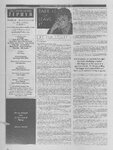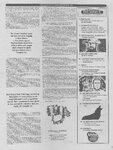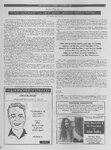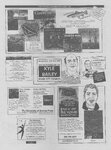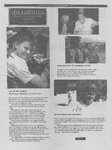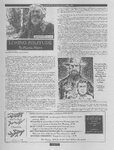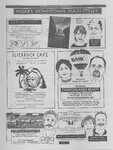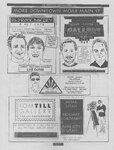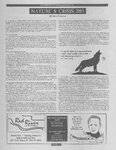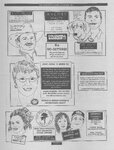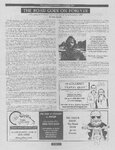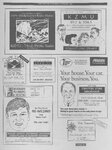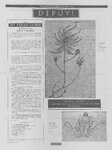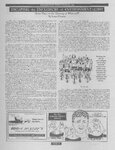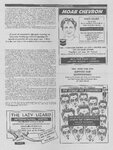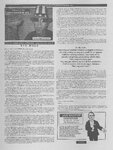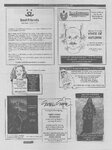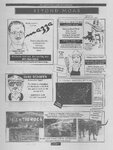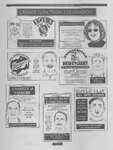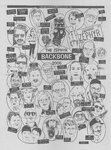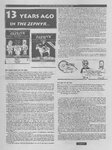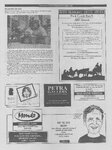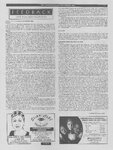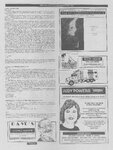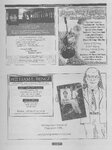| OCR Text |
Show | THE ZEPHYR/OCTOBER-NOVEMBER TIE CANYON COUNTRY ZEPHYR PO BOX 327 MOAB, UTAH 84532 Jim Stiles, publisher 435.260.1273 www.canyoncountryzephyr.com cczephyr®frontiernet.net 2005 i eis pulling the trigger who’s accountable and that’s us, in numbers too big toi To give a very specific example of the way their “science-based” approach to wilderness is ignoring Reality, consider a recent proposal by the Rewilding Institute that received considerable media attention. It’s an ambitious plan to re-wild the Great Plains and restore it with animals that disappeared 13,000 years ago from Pleistocene North America. The idea is to remove threatened species from Africa that are similar to those that were driven to extinction here and introduce them on the Great Plains. To quote from their web site: LEAVE i. Our vision begins immediately, spans the coming century, and is my contributing writers Ken Sleight Martin Murie Scott Silver Barry Scholl Chinle Mille Ned Mudd Dan Rosen Dave Foreman Lance Christie Philip Hyde Wendell Berry Bianca Dumas_ Robert Funkhouser Erica Walz Mike Roselle the artist John Depuy change |eee 1M sr Fe 5 a EDITOR’S NOTE: Sorry about the tiny type this time. So much to say...50 little space... “RE-WILDING” & “RATS IN A BOX” When June/July’s issue of The Zephyr containing “The Greening of Wilderne$$” finally saw the light of day, 1 wondered what some of my old enviro pals might think of it. While the Utah environmental community remains conspicuously and unanimously silent, I did hear from a couple of buddies from my Earth First! days. It began with an email from Moab’s Lance Christie, (NOT an Earth Firster!) who I’d quoted several times in the “Greening” piece and who asked for an opportunity to express his own take on the current crisis of | many Of course, | was more than happy to provide the space. Then, via Lance, I heard from Dave Foreman, one of the founders of Earth First! in the early 80s and a man I’ve admired for 25 years. Dave had seen the Zephyrarticle and offered an essay, “Nature’s Crisis: 2005,” for inclusion in this issue as well. Zephyr pilot & aerial reconaissance Paul Swanstrom webmaster Gary Henderson Subscriptions & transcriptions Linda Vaughan circulation JA Bryan Lance Lawrence Jose Churampi _ Mark Anderson Kathy Aldous THE ZEPHYR, copyright 2005 The Zephyr is published six times a year at Moab, Utah. The opinions expressed herein are not necessarily those of its vendors, advertisers, or even at times, of its publisher. All photos and cartoons are by the publisher unless otherwise noted We are stripped rela OU LeU Lew od Plenty. Winston Churchill o Sy) jer a t 7 Peps yy) thhe Lg PIeL use of conser I SE from managing Beco. to acti ely 1 eee natural processes. g historic phofographs Herb Ringer (1913-1998) 7, The idea is to actively promote the restoration of large wild landscape. This “Pleistocene re-wilding’ would be achieved through a seties of caretully managed ecosystem manipulations using closely related species as ee tor extinct large vertebrates, and would moabzephyr®yahoo.com -. yee | grounds. Then, from out of my ghosty past, a name I hadn’t seen in years appeared in my inbox...another EFler from decades gone by. Mike Roselle, the man Il once knew as Nagasaki Johnson, had somehow found the Greening story on the web site and offered his comments. Mike’s words were originally intended simply as a letter, but 1 asked him to expand it a bit and his observations are included here as well (“The Road Goes on Forever” So...you get to hear from three battle-scarred vets of the environmental wars that we've all been a part of for most of our respective adult lives. At the outset let me say that I admire all three of these gentlemen, respect their passion for the Land, and honor their visions for the future. But I believe and trust that they’re strong enough to withstand and even seek constructive criticism when it’s offered; I must admit, from my cynical perspective, Lance and Dave seek a vision of the future that is not wrapped in Reality. At the heart of their approach to wilderness is the belief that saving what remains of wild land in North America is not enough—that we must have the vision to “re-wild” the continent, a term first coined by - Dave in his thoughtful book and restore the land to what it once was. Both acknowledge that it will be a slow process, taking as much as a century to implement. Lance, in his essay, seems to believe that by proclaiming this “science-based” approach to wilderness, environmentalists will be able to remove themselves from the crass commercial exploitation and commodification of the natural world that was at the core of my “Greening” essay, and that somehow, by framin, the argument in these altruistic terms, we will do the right thing and restore the land to its fabled pristine glory of days long gone by. It’s a beautiful and inspiring dream of a North American continent that none of us has experienced. What is missing from their argument is not only critical but allencompassing. Lance never mentions the word in his essay and Dave’s reference to it is contained in one sentence. Over-population. “Rats in a box.” We all know that when you put | too many rats in a box they start eating each other. In the 21* Century, | we're fast becoming those desperate rodents. How do we develop wildlife corridors in a box full of cannibals? Dave notes in his essay only that, “human over-population is the underlying cause of all conservation and environmental problems.” Underlying. Indeed. It’s EVERYTHING. (1 willingly add here that both Christie and Foreman, in other essays and articles, have given more of their attention to the issue. But ultimately they seem to be saying, “Over-population is the ‘given’ here. How do we work around it?” ) Over-population is also an overwhelming contributor to this planet's social, economic, emotional and spiritual crises as well. From crime and | poverty to crowded parking lots. Much of the Earth, or at least its most | notable consumers, have embraced the free market global economy as we move recklessly into the future and that very premise REQUIRES that we continue to make stuffand create services that the exploding population will want to buy, in order to provide employment for the exploding population that needs work. That reality requires the consumption of our natural resources and its space at a rate that most o us cannot even begin to grasp. It’s why my tirades about Rich ir ICOMLE families who depend on the financial resources of the Rich have no choice. They need the work. It’s the ultimate Catch-22. From Rewilding North America, Foreman identifies the planet’s six global wounds: direct killing of species, loss and degradation of ecosystems, fragmentation of wildlife habitat, loss and disruption of natural processes, invasion by exotic species and disease and poisoning of land, air, water and wildlife. Then he lists the causes of each of these wounds. Among the causes are: “agricultural clearing, grazing, mining, wetland draining, urbanization, sprawl, water diversions, road building, ORV use, pipelines, feedlots, factories, smelters, and toxic wastes.” (This is partial and not even close to the complete list Dave offers.) And of course, on one level he’s correct. But that’s like insisting that a loaded .357 Magnum is the cause of a gunshot wound. It’s the guy No one can question the sincerity or even the extraordinary vision of such a plan. But how is it they chose the Great Plains as its laboratory for this proposal? Here’s what the Institute says: “although human land-use patterns are d) lynamic and uncertain, in some areas, such as a of the Great Plains in the United States, L L ig—which may opportunities. That’s true. The Great Plains is the only part of America that currently shows a decliningp communities scattered across the vast prairies of Nebraska, Kansas, and the Dakotas are beyond facing an “uncertain future.” That they’re irrevocably doomed to be the next generation of abandoned ‘ghost t wns. I can recall, 15 years ago, the town of Moab, Utah being described in just those terms. Moab, Utah, once the “Uranium Capital of the World,” And of course, on one level he's right. But that's like listing a loaded .357 Magnum as the cause of a gunshot wound. It's the guy pulling the trigger who's accountable and that's us, in numbers too big to ignore. was about to dry up and blow away. A quarter of its homes sat empty and for sale at rock bottom prices. Moab was about to become a ghost town itself. a Pretty damn funny. Let me provide my own “vision” of the Great Plains’ future. As the United States population continues to expand—from 150 million in 1950, to 300 million by 2007, to 400 million by 2050, to 750 million by 2100, the south and southwest parts of North America will fill to and beyond capacity. Rural communities in the Intermountain West will become small urban nightmares of their own and people who were “newcomers” to places like Moab in the early years of the 21* Century will wonder, “What has happened to our town?’ One day, twenty or thirty or forty years from now, maybe sooner, when barely a trace of Old America remains, some trans-continental traveler, racing fromh home in Wisconsin to his winter home in Sedona, will grow weary of tl Interstate 70 and opt foraside-road. He'll discover these al mostly forgotten communities with their brick streets and old homes and the rare locally owned cafes and even rarer friendly faces and be stunned by his “discovery.” “This is incredible!” he'll squeal. “Why this is...this is just like America used to be! It’s so...authentic! It’s: so quaint!” He'll rush to the local real estate office and discover that home prices are not just affordable...they’re a damn steal! And he’ll buy four homes in one day, just like out-of-town speculators did to Moab in 1988. Stories will appear in national magazines about “The Last Secret Places in North America.” “Remember what a Quiet Life once was? Re-discover ‘Old America.’ Come to Nebraska! Americans will flock to the Great Plains in numbers that will overwhelm its original citizens. But they won't be able to sell-out fora good profit and go elsewhere for a quiet life. The Great Plains will be the end of the line. No more escapes after that. Critics of my vision might argue that the Plains are too inhospitable, too cold, too barren, too bleak to ever appeal to a large human migration, But if you were a smothered rat in a box, wouldn't Grainfield, Kansas sound awfully damn appealing to you? Until I see the environmental movement actively, passionately embrace the issue of population and acknowledge that without a dramatic turnaround in the human numbers in the next century, we are doomed to lose what's left of our “natural world,” I can’t bring myself to take any of these visionary plans seriously. We can’t stop an avulsed wound with a Band-Aid. We cannot build a Utopian Wilderness in the middle of a sewer teeming with crazed rats, and that is about to become our last unworkable option. RANGERS SHOULD ‘RANGE’ When Chief Ranger Jerry Epperson hired me to be a seasonal ranger at Arches National Park, so many years ago, I wasn’t even sure what my duties were supposed to be. So it seemed like a good idea to ask. Epperson smiled wryly and said, “A ranger should range.” And while all of us endured the other Park Service chores like collecting fees and working the visitor center information desk and cleaning toilets and admonishing the tourists for their often almost unbearable ignorance, we still preferred to ‘range’—to get into the backcountry and explore—any time the opportunity allowed us to. To know a piece of land, for no other reason than the intimacy between you ; |

